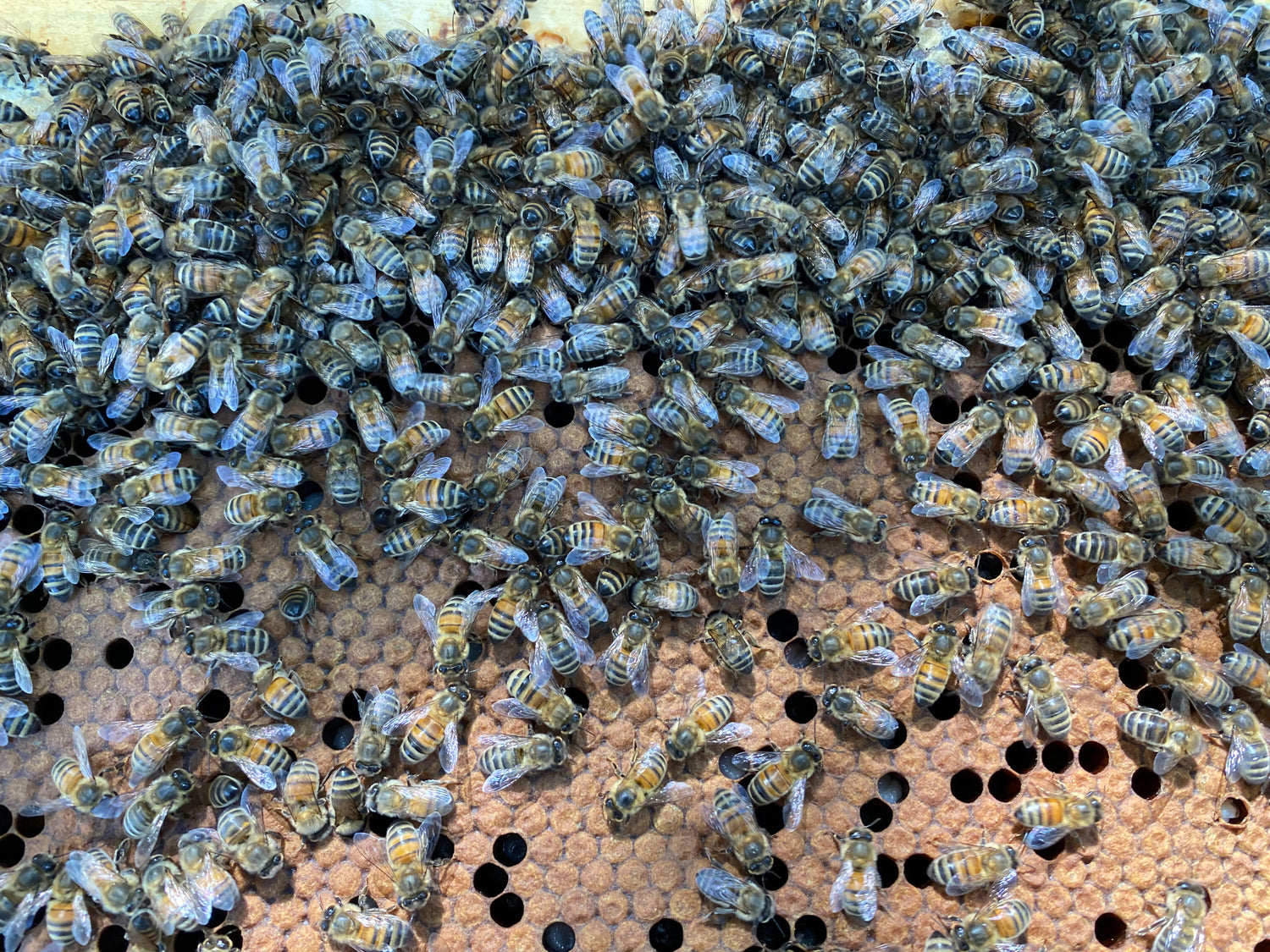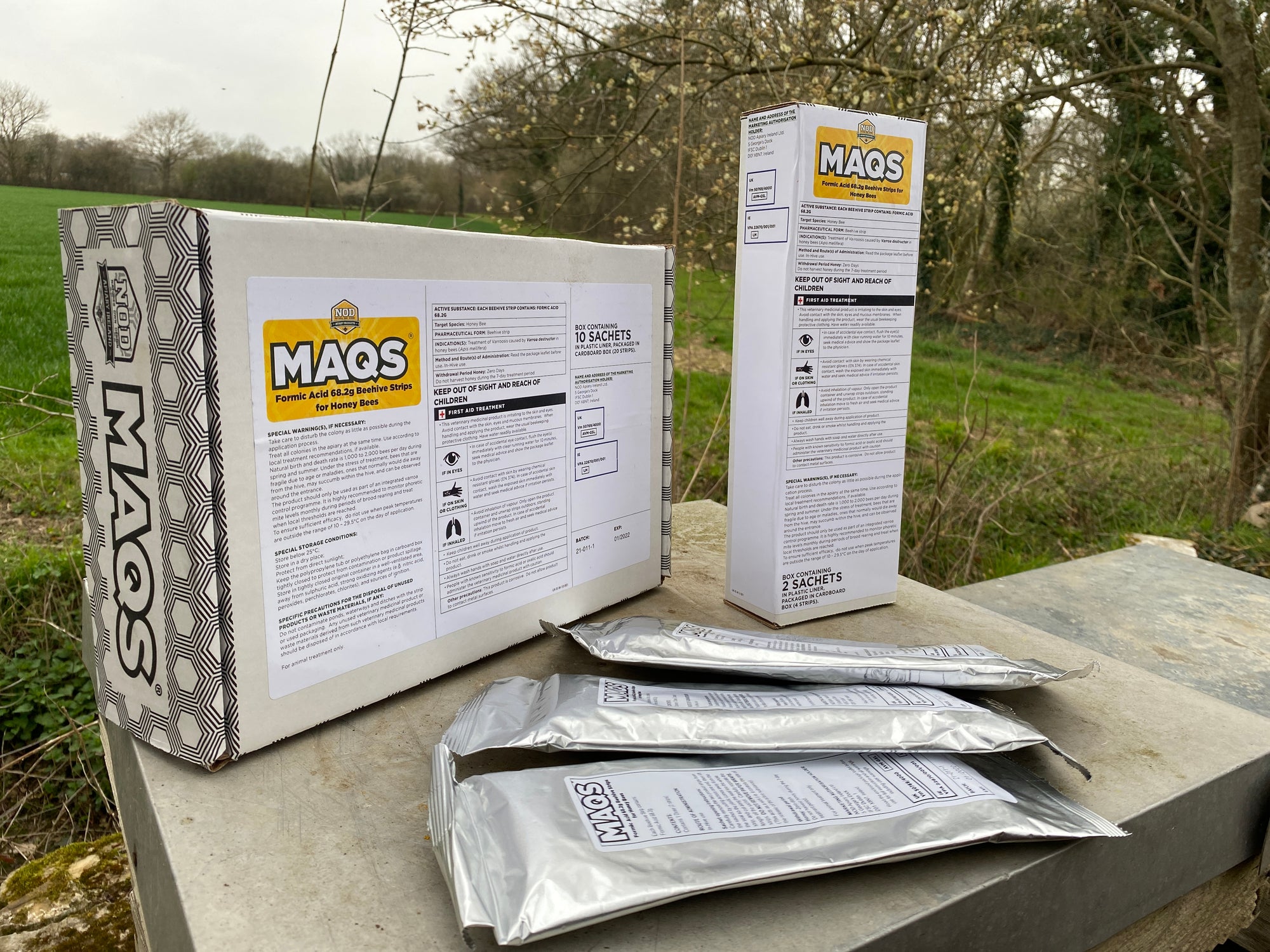Introduction to Varroa mite
Whether we have two colonies or two thousand colonies, we all want to be responsible beekeepers in the UK. To achieve this, one of the most important areas we must consider is how to tackle the biggest pest that the Western Honey Bee faces, the Varroa mite (Varroa destructor).
Unmanaged varroa mites in your hive affects everything in the colony; from each individual honey bee lifespan to the amount of honey the colony produces. Varroa mites act as a disease vector into the hive and reduce the health and resilience of your bees. If we do not manage the varroa populations in our hives effectively, we leave our colonies defenceless against a parasite that is here to stay.

Varroa mite background
The Varroa mite (Varroa destructor) is an external parasitic mite that parasitizes the Western Honey Bee (Apis mellifera). Originally only parasitizing the Asian Honey Bee (Apis cerana), Varroa now also parasitizes the Western Honey bee and its hive to feed, reproduce and sustain itself. It was first discovered to be present in the UK in April 1992 and has since spread across the country, infesting honey bee colonies nationwide. Varroa mites have led to the elimination of many feral bee colonies across the UK and are a major problem for managed colonies.
The varroa mite has two stages in its life cycle, the reproductive stage and the phoretic stage. During the reproductive stage of its life cycle, the bee mite exists within the brood cell of the honey bee. A mature female varroa mite will move into an uncapped brood cell to lay her eggs and once the cell is capped, she will lay her first unfertilised egg within a few days. This will hatch into a male after which she usually lays three to four fertilised eggs that will hatch into females. The last eggs laid will not reach maturity because the duration of the capped brood cell stage in western honey bees is too short, particularly the worker brood cell. The mature varroa mite climbs onto the emerging adult bee and uses the bee to move from one host to another. The bee mite is found in the drone brood cell more. This is because the duration of pupal drone development gives the varroa extra time to lay more eggs and produce more mature offspring before the adult bee emerges.
The varroa mite uses the honey bee fat body tissue as a main source of nutrients, feeding directly on the honey bee larvae within the brood cells. A recent study carried out by Samuel Ramsey (2019, PNAS 116(5):1792-1801) has highlighted that the varroa mite feeds primarily on the honey bee fat body tissues and not the honey bee haemolymph (blood) as originally thought. The fat body tissues in the honey bee function as the liver does in mammals so it plays an important role in honey bees overall health. The tissue is responsible for proper immune function, pesticide detoxification, overwinter survival, and several other essential processes in healthy bees. The varroa targeting this vital tissue means that varroa infestation leads to catastrophic effects on individual bees and as a result the whole colony.
Varroa Control Strategies
An extensive study carried out by Genersch et al. (2010, Apidologie 41: 332-352) showed a correlation between colony mortality in winter and percentage of varroa infestation. In short if you have between 5-10% varroa infestation, you are likely to lose 8-10% of your colonies. If your varroa infestation is just 10% higher than this at 20%, you are likely to lose 40-50% of your colonies. This significant difference cannot be ignored and highlights the importance of varroa control.
We can see why it is extremely important to control the varroa mite population in honey bee colonies. The best way to control varroa is an Integrated Pest Management strategy (IPM) involving year-round treatments which control the population of the varroa mite in the hive. Andermatt offer a comprehensive selection of bee health products that can underpin an effective IPM and used to control varroa in your hives. Many of our products are developed and produced in Switzerland by our sister company Andermatt Biovet and are brought to you by Andermatt UK to bring UK bee keepers the products needed to implement your own integrated pest management strategy. More information on the Andermatt bee health product range and how to buy them can be found by clicking here.
As part of an IPM strategy, beekeepers nationally are using selective breeding to increase hygienic behaviour into their honey bees as another way of combating the varroa mite. A study carried out by LASI (The Laboratory of Apiculture and Social Insects) on the effects of hygiene on bee pests and diseases showed that hygienic behaviour can play an important role in controlling varroa and the viral diseases it transmits. This is one way of helping the bees build up a natural tolerance to the bee mites, however this on its own this will not work to control the varroa completely. It will take many years to breed a high level of innate hygienic behaviour into honey bee colonies and due to the nature of the way virgin queens are open mated, the hygienic behaviour will likely be diluted easily if you do not artificially inseminate your queens. Selective breeding of hygienic behaviour as part of an extensive integrated pest management strategy is an effective way to control varroa.
Removing capped drone brood (particularly just before the spring honey flow) by simply cutting it out or using a comb fork is another method used by bee keepers to control the varroa mite population and used as part of an integrated pest management strategy will have an effect on the varroa population in your hives.
When the varroa mite was initially discovered in the UK in 1992, beekeepers used varroa treatments with pyrethroid compounds to tackle the varroa mite. The pyrethroid compound specifically attacks the nervous system in the varroa mite. Over reliance on these treatments gave the varroa time to build up a resistance to them by changing their genetics to tolerate the compound. As a result, these treatments are now viewed to be ineffective on the varroa. The bee mite treatments that have proven to be effective and are currently used in the UK have active ingredients such as Thymol, Oxalic acid, Formic Acid and Lactic Acid. These organic compounds have a more general effect on the varroa mite. They denature the proteins in the varroa, and the mite’s body breaks down which means it is very unlikely that the bee mites will be able to build up a tolerance to these compounds.
Thymol treatments such as Thymovar by Andermatt are the most widely used long term varroa treatments. The duration of treatment is between 6-8 weeks (2 Applications each of 3-4 weeks) which means the long period of activity protects from varroa reinfestation in the hive. Thymovar is well tolerated by the queen and brood, it is easy to handle and fast to apply: simply cut or break the strips into pieces and use the correct amount needed for the size of your colony. Place directly over the brood nest on the top of the frames in a circular pattern around the brood leaving space between the crown board and strip.
Oxalic acid treatments are proving to be highly effective against varroa throughout the year. In the UK the winter is a time of year when the varroa population can be at its most vunerable. With some colonies having no sealed brood to reproduce in, the mite has to exist for long periods of time phoretically (travelling on the body) on the adult bee. The trickle method at this time of year (around the winter equinox) using oxalic acid mixed with sugar is a method that many UK bee keepers favour. Oxuvar oxalic acid solution can be mixed with sugar for the trickling method. Oxuvar can also be mixed with water to spray directly onto the bees during the spring, summer and autumn. The solution is sprayed directly onto the bees and the water evaporates, leaving the oxalic acid on the body of the bee to come into contact with the varroa. This treatment is perfect to treat swarms, packages of bees, nuclei or broodless colonies and can be an effective way of ensuring that any bees coming into your apiary are treated for varroa.
In the UK we have a short bee keeping season. This short season creates the need to ensure our colonies are at optimal size and condition at the right time. If the varroa mite is not correctly controlled consistently this will have an impact on the overall outcome of your bee keeping season, it will affect the overall health of your bees going into winter and also it will affect the amount of honey your bees collect.





